|
5 - On The Trail Of The Indians
From the southernmost tip of Sicily to Hammerfest, the most
northerly town in Europe, you fly over eight countries in the course
of your 2,500-mile journey. Flying from Moscow to the South Yemen,
which is about the same distance, you see seven nations below you.
But if you fly from Cacipore to the Rio Grande, some 2,500 to 2,700
miles in a north-south direction, there is only one country below
you all the time: Brazil. It is just the same in a west-east
direction-from the Peruvian border to Recife on the Atlantic Ocean
it is all Brazil. With a surface area of 3,289,440 square miles, the
gigantic South American country is only exceeded in its endless
extent by Russia, China, Canada and the USA. Besides being vast,
Brazil is full of mysteries.
If a pilot of the VASP airline on a routine flight of 1,250 miles
sees towers or villages or ruins that are not marked on the map, he
notes down their geographical position and makes a report. But if
someone sets out to verify the data only three days later, the
towers, villages or ruins may have already disappeared. What was
only briefly visible in favorable weather conditions, when the wind
was right or after a forest fire, has already been overgrown,
swallowed up again by that green Moloch, the forest.
Brazil is a country of extremes. It is as difficult to get to know
its present as it is to get to know its past. Since Dodge, VW, Ford
and Chevrolet have been making all kinds of cars here, army pioneers
are constantly turning up archaeological finds when building the new
roads intended to open up the vast territories which are still
inaccessible. No one can estimate how much unique material is lost
forever in the mountains of debris excavated.
Archaeology is a universal hobby in Brazil, but professional
archaeologists are rare. If finds as rich as these were made in
other countries, universities would initiate research projects or
governments provide financial aid for excavation teams under expert
leadership. It is quite different here. The size of the country and
the multiplicity of archaeological riches, most of them virtually
inaccessible, mean that planned digging, classification and
excavation scarcely ever take place. Even if a forgotten prehistoric
town is accurately located and accessible with the right kind of
vehicle, it takes years before the money to equip a modern
expedition is available. Only too often the result is that it comes
too late.
Archaeological finds in Brazil are mostly due to the luck, industry
and keenness of enthusiastic laymen. The Austrian Ludwig Schwennhagen was one of them. He was a teacher of philosophy and
history and lived for a long time in Teresina, the capital of the
north Brazilian state of Piaui. Schwennhagen was the first man to
give a detailed description of the mysterious Sete Cidades (Seven
Cities) in his book Antiga Historia do Brasil, published in 1928.
When the second edition of his book came out in 1970, Schwennhagen
had long since died a poor schoolmaster.
I first heard the name of Schwennhagen from the lips of Dr.
Renato Castelo Branco, who brought
me an invitation to visit Sete Cidades as the guest of the
Government of Piaui.
“Whereabouts are these Sete Cidades?” I asked.
“Only 1,875 miles away as the crow flies,” answered Dr. Branco.
“North of Teresina, between the town of Piripiri and the Rio Longe.
We can be there the day after tomorrow.”
There were two reasons why
we landed at Teresina at government expense. Firstly, Chariots of
the Gods? and Gods from Outer Space have gone into several editions
in South America (especially in Brazil) and open all doors to the
author. Secondly, the Governor of Piaui wants to turn the site of
Sete Cidades into a national park and is grateful for any publicity
which will further his plans. A well-built road covers the hundred
miles from Teresina to Piripiri.
The landscape is flat and dark
green; the verges of the road are covered with undergrowth that is
bordered by dense jungle. Wild pigs, wild cows and wild horses make
the journey somewhat dangerous. Although the district is almost on
the equator, the climate is bearable. A gentle breeze blows
constantly from the coast some 200 miles away. From Piripiri you
travel to Sete Cidades by a rough ten-mile road that can be used by
cross-country vehicles.
Suddenly and without warning you are
confronted by the first ruins. (Fig. 54.)

Fig 54.
Plan of Sete Cidades (Seven Cities),
which clearly shows
order among the chaos of rocks destroyed by apocalyptic forces.
Well, ruins is not quite the right word here. There are no
disordered remains of stones that were once built up in layers.
There are no monoliths with sharp edges and artificially carved
furrows as on the Bolivian plateau at Tiahuanaco. Even after making
an intensive search and using your imagination to the full, you can
find neither steps, nor stairs, nor streets which could have been
lined with houses.
Sete Cidades is one monstrous chaos, like the
biblical Gomorrah that was destroyed by heaven with fire and
brimstone. Stone has been dried out, destroyed, melted by
apocalyptic forces. And it must have been a very, very long time
since the titanic conflagration raged. No one has ever excavated
here.
Science has never attempted to uncover the different strata of this
primordial stone past.
Here bizarre stone shapes, articulated monsters, shoot from the
ground like question-marks. An educated guide, attached to me by the
Governor of Piaui, told me that the Seven Cities’ strange contorted
shapes had been formed by glacial deposits. As I know perfectly well
from my home-country Switzerland, when glaciers all over the world
withdraw, they leave behind an unmistakable broad band of eroded
stone. There are no such traces here. Sete Cidades describes a
fairly accurate circle with a diameter of 12 miles. My guide put
forward another speculation. In the past there had been a sea-basin
here and the Seven Cities were simply the remains of washed out
stone; wind and temperature changes had sculpted the strange
picturesque “ruins.” (Fig. 55.)
It might be true. Why not?
I have seen with my own eyes some of the fantastic structures which
have come into being through the inventiveness and inexhaustible
potentialities of nature. Death Valley in the USA, the Salt
Cathedral in Colombia, the granite cauldron in Bolivia and the
bizarre, almost architecturally articulated rock fissures on the
Dead Sea-they were all wonderful and bizarre enough. There are many
strange follies made by the great master-builder, nature.
But in some inexplicable way everything seemed to be quite different
at Sete Cidades.
The arrangement of the “ruins” into seven districts can be clearly
seen on the “official map” of Sete Cidades. Coincidence? A caprice
of nature? I cannot accept that so much deliberate arrangement was
caused by natural forces and I felt it much more likely that a
definite plan lay behind it all. But what disconcerted me most were
the crumb-like bits of metal squashed between the layers of rock and
protruding from them that left traces of rust like long tears on the
walls. This feature occurred too often and too regularly in the
midst of all the chaos.
It is possible that there may be a
geological explanation for the “tortoise” (Fig. 56), the special
attraction of Sete Cidades, but in the absence of research we know
nothing.
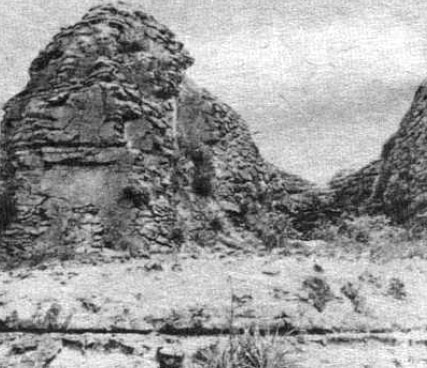
Fig. 55.
Detail of the ruined site of Sete Cidades, where the
arrangement in seven districts can still be distinguished in spite
of the chaos.
So far no scientific investigation of the foundations
has been undertaken.
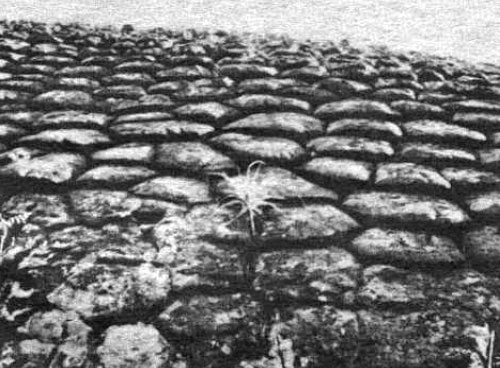
Fig. 56.
The “tortoise” is the special attraction in the wilderness
of Sete Cidades.
In the absence of
research, nothing positive can be said about it.
Although the origin of the Seven Cities is still unexplained, the
rock paintings are an established fact. You can see them and
photograph them. And there can be no doubt that the paintings are
considerably more recent than the rough weather-worn stone
monuments. Sete Cidades has two “pasts”: one a dark primordial past
that can probably never be reconstructed, and a “modern” one,
although even that dates to prehistoric times.
Once again not even the cleverest man on earth knows who painted the
paintings on the walls. Yet it very soon becomes clear that the
prehistoric artists, with few exceptions, liked to use the same
motifs and symbols as are found in cave and rock paintings all over
the world. Circles, wheels (with spokes), the sun, concentric
circles, squares inside circles and variations on crosses and stars.
Just as if all prehistoric artists, even those in the most remote
parts, had visited the same art school! In his book Kult Symbol
Schrift, Oswald O. Tobisch has shown in tabulated form that rock
drawings in Africa, Europe, Asia and America are related to each
other.
At the end of his comparative studies
Tobisch asks in
amazement:
“Is it possible that once there was a unified concept of God on an
international scale simply inconceivable to our present way of
thinking and that mankind in those days was still in the ‘field of
force’ of the ‘primordial revelation’ of the one and almighty
creator, to whom mind and matter, the whole universe with the
heavenly bodies and living creatures, were and are subordinate?”
Here I am only going to introduce a few examples of the rock
paintings at Sete Cidades, but I shall be glad to place my extensive
collection of color photographs at the disposal of research workers.
The red and yellow circles, which are obviously some kind of signal,
are noteworthy, especially because rock paintings in two colors are
rare.
Undoubtedly they were intended to transmit some special
message. (Fig. 57.)

Fig. 57.
The red and yellow circles, obviously a kind of signal, are
striking.
The technical sketch shaped something like a test-tube in
the lower half of which two ropes with signal flags are
recognizable, is remarkable (and so far has no counterpart
elsewhere).
On a sturdy blood-red staff, 12 ½ inches high, there are
five ovals like the balls on Christmas trees. Nothing from the real
world of prehistoric men-animals, plants, stars-can have served as a
model for them. (Fig. 58.) Then there is a line, below which jour
balls dangle like notes of music. As prehistoric men did not know
any musical notation-who can deny that?-they must also be meant to
convey a message.
There is an ancient Indian relief with nine “notes
of music” below and two above the central line that is almost a
counterpart to it. Indian research workers easily identified the
relief from descriptions in Sanskrit texts as the representation of
a
Vimana, i.e. a flying machine. (Gods from Outer Space.)

Fig. 58.
This technical looking plan is remarkable and to the best of my
knowledge
without parallel in the international catalog of rock and
cave paintings.
A test-tube?
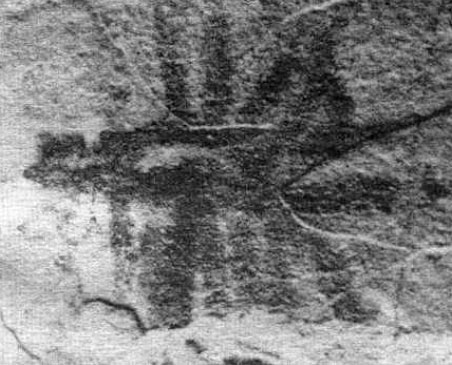
Fig. 59.
Rock and cave painters always stylized objects in their
perceptual world.
What was the model for this simple flying machine?
Another very remarkable example, in my opinion, was a flying machine
(Fig. 59) that might have been drawn by a child. Prehistoric
painters stylized everything they saw in an extremely simple way.
What served them as a “model” here?
But to me the most extraordinary and impressive painting was a wall
with astronauts on it. It shows two figures with round helmets, and
floating above them a thing that visionaries would call a UFO. A
spiral winds between the figures. Next to it a form is reproduced
that an imaginative mind could interpret in a limitless number of
ways.
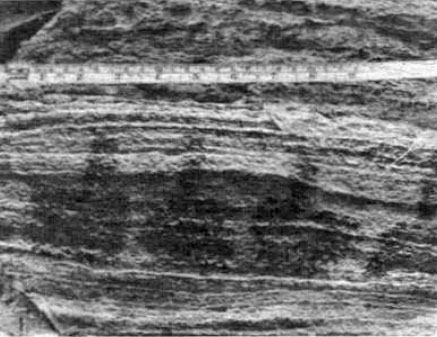
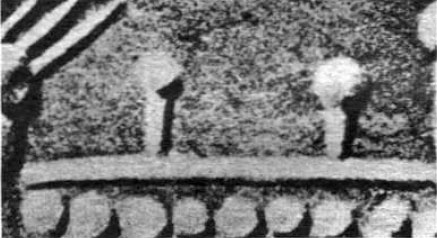
Fig. 60.
The drawing high up on a rock face at Sete Cidades
is
identical in style and layout with an old Indian bas-relief
which
was identified by Sanskrit scholars as a Vimaana, a flying machine.
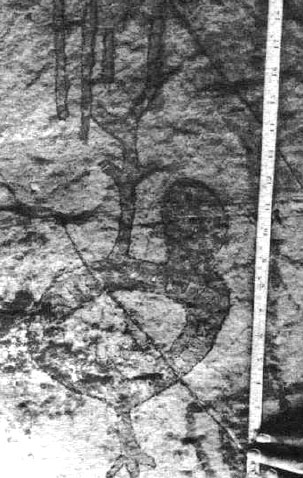
Fig. 61.
A tricky puzzle to solve.
A space station in orbit?
Concentric circles with little windows?
One of the most puzzling
finds at Sete Cidades!
A difficult kind of rebus. What can it be? A space station in orbit?
(Fig. 61.) A circular band with little windows on the side facing us
... a band with a protuberance ... with a bifurcation above it. I
have gone over the outlines of the drawing with charcoal to make it
clearer. Last but not least, a primitive drawing which shows an
astronaut in a complete spacesuit. In the company of Ernst von Khuon, I ask the question: were the gods astronauts?
The place where these rock paintings were found is also very strange
and (so far) inexplicable. All the examples of rock drawings
reproduced here float at a height of 26 feet on a very inaccessible
wall. I think that the painters (provided there were no giants!)
stood on a platform of stone blocks while they were working. But
with the passage of time this platform must have been worn away by
weathering because there is absolutely no trace of it to be found
below the high wall.
The weathering away of the platform could be a
clue to the great age of the rock paintings at Sete Cidades. The
reserves of
the Hopi Indians, members of the large Pueblo group, are
located in Arizona and New Mexico. Today there are still about 8,000
Hopis in existence.
They weave extremely beautiful baskets,
following an ancient handicraft tradition, and make magnificent
pottery. In spite of the pressure of the blessings of civilization,
the Hopi Indians on their reserves have preserved their age-old
rites and customs, as well as their orally transmitted legends in an
astonishingly pure form.
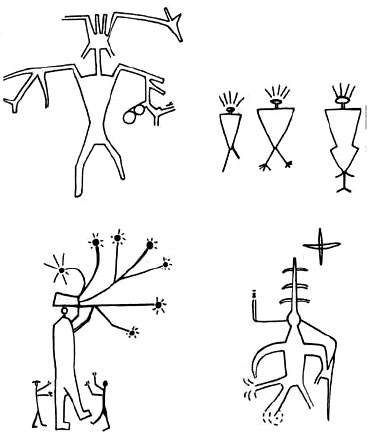
Fig. 62.
Large numbers of Petroglyphs can be seen on the rocks of
the reserve,
although they are often hard to get at.
Of the four
sketches chosen, the “Star Blower” is the most striking.
Antenna-like attributes can easily be recognized.
White Bear is chieftain of the Coyote clan by right of birth. He can
still read most of the ancient “drawings” carved in the rock. Thus
White Bear knows that a hand with outspread fingers next to the
paintings means that the tribe who once executed the drawings is
still in possession of the whole traditional wisdom. White Bear is
capable of interpreting widely separated rock and cave drawings that
he has never seen before. Unfortunately the chieftain is very
reticent and extremely skeptical of white men (with good reason).
The Petroglyphs in the reserves are of remarkable design and
sometimes whole rock faces are covered with them. (Fig. 62.)
What have the legends of the Hopi Indians to tell us?
They say that the first world was Toktela. (Toktela literally means
infinite space.) Only Taiowa, the creator, originally dwelt in the
first world before he created men. The ancestors had been in contact
with various worlds before they found their home on this planet.
Taiowa told them that the supreme law was “Thou shalt not kill.” If
there were any differences of opinion or disputes between the Hopis,
the opposing parties separated, went off in different directions and
sought new hunting grounds. But both sides stuck to the traditional
laws and kept on covering rocks and caves with the same paintings
during their long marches. (They still observe this practice today.)
In the Book of the Hopi (the first revelation of the Hopi’s
historical and religious world-view of life) the following legend is
told:
“In ancient times there was a battle for the Red City in the South.
Wherever they came from, all the tribes were accompanied by
Kachinas, beings who were reputed not to be of the ‘fourth world,’
indeed, they were not men at all. Nevertheless, they always proved
themselves to be protectors and advisors of the tribe and frequently
helped them out of tricky situations with superhuman powers and
arts.
This was what happened in the Red City in the South when some
Hopi tribes were suddenly attacked from all sides. With the speed of
the wind, the Kachinas built a tunnel through which the Hopis were
able to flee into the open behind the enemy lines without shedding
blood. When they said goodbye, the Kachinas said to the chieftains:
‘We are staying to defend the city. The time for the journey to our
distant planet has not yet come!’”
If we follow the Hopi traditions,
all the red rock drawings are simply very early messages with
precise instructions to tribe members who might happen to pass
through that particular bit of territory at any given time.
It would be an interesting experiment to show Big Chief White Bear
my color photographs of rock and cave drawings at Sete Cidades. Who
knows, perhaps he would “read” in the remarkably similar symbols and
motifs that the mysterious Red City of the South had been
rediscovered at last. Back in Teresina, I looked forward keenly to a
meeting with Felicitas Barreto (Fig. 63), a Brazilian who is an
Indian scholar of high standing.
Her book Danzas Indigenas del
Brasil (Native Dances of Brazil), with descriptions of the ritual
dances of various wild Indian tribes, had made a deep impression on
me. We had been in correspondence for some years and now I was going
to meet her in person. Mrs. Barreto, “lost” to civilization for 20
years, came from the godforsaken region of the Upper Rio Paru, on
the borders of Brazil and French Guiana. The Brazilian Air Force was
bringing her to Belem. I had guaranteed a return flight from there
to Teresina.
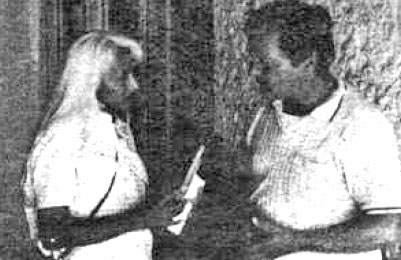
Fig 63.
I met Felicitas Barreto the celebrated Indian
scholar, at Teresina.
She has lived in the jungle with Indians on
the banks of the Rio Paru for 20, years.
“Good heavens, how noisy it is in this town! Can’t we creep into
some quiet corner?” said Mrs.
Barreto, a middle-aged lady with a wiry figure.
I found the quietest
room in the Hotel Nacional.
Below I reproduce some of the conversation I took down on my tape
recorder:
“How long is it since you have been in a town?”
“About twenty months, but one day will last me for a very long time.
Already I’m homesick away from my Indians in the virgin forest.”
“Homesick?”
“Yes, for nature. I’ve learnt to converse silently with the sticks
and stones, with animals and dewdrops. The Indians don’t talk much, but we understand each other
perfectly.”
“You live among wild Indians. Why don’t they kill you, since you’re
a white woman?”
“The Indians don’t live up to their reputation, and
anyway I am a woman, and a woman is like a snake without venom, like
a weapon without a point. They call me ‘pale half-moon’ because of
my blonde hair. All the tribes know about me, they all know me by
that name and if I move on to another tribe, I am always given a
friendly reception.”
“What do you wear? Jeans?”
“Good lord, no! Mostly I go about naked or in a grass skirt. The
chief of the tribe I’m studying now has invited me to be his third
wife.”
“For heaven’s sake! Surely you haven’t said yes?”
“Not yet, but it would be nice to be a chief’s third wife. As third
wife I should have the least work to do. Besides, three of us could
give the chief a sound thrashing.”
“Really?”
“Yes, why not? If an Indian does not treat his wives properly or
plays tricks on them, his wives beat him. After he has had his
beating, he has to leave the house, go to the river and stay there
in a kneeling position. If none of his wives fetch him before
evening, he has to spend that night and all the following nights in
the men’s house and look for new wives. Perhaps these strict customs
are the reason why Indians are perfect gentlemen. And I must add
that the tribe never deserts anyone, even if he is being ostracized
or is seriously ill. Twice I was bitten by poisonous snakes, I lost
consciousness for several days and the Indians looked after me and
cured me with plants which they chewed and applied to the wound.”
“You know my books. What do the Indians have to say about the idea
that man comes from the universe?”
“Let me answer your question with a legend that is told by the
Kaiato tribe. They live on the Upper
Xingu in the State of Mato Grosso. Incidentally all the tribes know
this legend or similar ones.
“Far away from here on an alien star
sat an Indian council that decided to change the tribe’s dwelling
place. The Indians began to dig a hole in the ground, deeper and
deeper, until it came out on the other side of their planet. The
chief was the first to rush into the hole and after a long cold
night he came to the earth, but the air resistance there was so
strong that it blew the chief back again to his old home. Then the
chief told the tribal council about his experience, that he had seen
a beautiful blue world with a lot of water and many green woods and
that he advised that all Indians should go to this world. The
council decided to follow the chiefs advice and ordered the Indians
to plait a long cotton cord. On this cord they slowly lowered
themselves into the hole so that they too would not be blown back
from the earth. Because they entered the earth’s atmosphere slowly,
their mass migration was successful and since then they have lived
on earth. In the beginning, relate the Kaiato, contact was still
maintained with the old home through the cord, but one day a wicked
magician cut it in two and since then they have been waiting for
their brothers and sisters from their old home to seek and find them
again on the earth.”
“Do the Indians also speak about the stars?”
“Not about the stars, but to the stars! They often sit motionless in
a circle for hours, holding each other by the shoulder as in an
endless chain and not saying a word. If you ask one of the men who
was present (after the session is over) what they all did, you would
certainly not get an answer, but I know from the women that the men
are conversing with heaven.”
“Are they praying then?”
“No, they are carrying on silent dialogs with someone up there.”
Mrs. Barreto hunched her shoulders and pointed to the ceiling.
“Tell me, do the wild Indians still have any rites or ritual objects
that point to any land of connection with the universe?”
“Oh yes! There are the feathered men, Indians who cover themselves
with feathers from head to foot, to make themselves look like birds
who can rise into the cosmos so easily. And then there are the
countless types of masks, which, if one likes, can all be
interpreted along the lines of your theories. Many of the masks have
branches with several forks springing from them like the antennae in
your cave drawings.
Often the Indians completely disguise themselves
in straw to make themselves resemble their fabulous ancestors. Joao Americo Peret, one of our outstanding Indian scholars, recently
published some photographs of Kayapo Indians in ritual clothing that
he took as long ago as 1952, long before Gagarin’s first space
flight! If you look at those photographs, the first thing you think
of is astronauts. The Kayapos, not to be confused with the Kaiato,
live in the south of the State of Para on the Rio Fresco.”
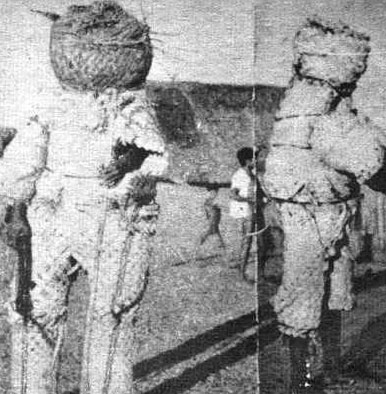
Fig. 64.
Dr. Joao Americo Peret took these photos of Kayapo Indians
in 1952,
when no one had any idea how astronauts dressed.
The
Indians wear these ritual robes in memory of the appearance of the
heavenly being Bep Kororoti.
Joao Americo Peret very kindly allowed me to use copies of his
photographs of Kayapos in their “ritual garments” as illustrations
to this book. (Fig. 64.) He took them in an Indian village on the
Rio Fresco, south of Para.
In view of this really astonishing
masquerade I feel that it is important to reemphasize that Peret
took these photographs in 1952 at a time when the clothing and
equipment of astronauts were still not familiar to all us Europeans,
let alone these wild Indians! Yuri Gagarin orbited the earth in his
spaceship Vostok I for the first time on April 12, 1961, and only
since that event have astronauts in their suits become as familiar a
sight as mannequins in shop windows. The Kayapos in their straw
imitation spacesuits need no commentary apart from the remark that
these “ritual garments” have been worn by the Indian men of this
tribe on festive occasions since time immemorial, according to
Peret.
The Kayapo legend that Joao Americo Peret told me needs no
commentary either. Peret heard it in the village of Gorotire on the
banks of the Fresco from the Indian Kuben Kran Kein, the old
counselor of the tribe, who bears the title of Gway Baba, the wise.
This is the legend which the sage related:
“Our people lived in a big savanna, far away from this region, from
which one could see the mountain range Pukato Ti, the summits of
which were enveloped in a cloud of uncertainty and this uncertainty
has not been cleared to this day. The sun, tired from its long daily
walk, lay down on the green grass behind the brushwood and Mem Baba,
the inventor of all things, covered the heaven with his cloak full
of hanging stars. When a star falls down, Memi Keniti traverses
heaven and takes it back to the right place. That is the task of
Memi Keniti, the eternal guardian.
“One day, Bep Kororoti, who came from the Pukato Ti mountains,
arrived in the village for the first
time. He was clad in a bo (i.e. the straw suit in the pictures),
which covered him from head to foot. He
carried a kop, a thunder weapon, in his hand. Everyone in the
village was terrified and fled into the bush. The men tried to
protect the women and children, and some of them attempted to fight
the intruder, but their weapons were too weak for they crumbled to
dust every time they touched Bep Kororoti. The warrior who had come
from the cosmos must have laughed at the weakness of those who
fought against him. To demonstrate his strength he raised his kop,
pointed it first at a tree and then at a stone, and destroyed them
both. Everyone believed that in so doing Bep Kororoti wanted to show
them that he had not come to wage war with them.
“Confusion reigned for a long time. The bravest warriors of the
tribe tried to organize resistance, but in the end they could only
succumb to the presence of Bep Kororoti, for he did no harm to them.
His beauty, the radiant whiteness of his skin, his obvious affection
and love gradually enchanted everyone. They felt safe with him and
became friends.
“Bep Kororoti took pleasure in learning how to use our weapons and
how to become a good hunter. He progressed so well that he could
handle our weapons better than the best men of the tribe and was
braver than the bravest men in the village. It did not take long
before Bep Kororoti was received into the tribe as a warrior and
then a young maiden sought him as a husband and married him. They
begot sons and a daughter, whom they called Nio Pouti.
“Bep Kororoti was more clever than anyone else so he began to
instruct the others in unknown matters. He led the men in the
construction of a Ng Obi, the men’s house that all our villages have
today. In it the men told the youngsters about their adventures and
so they learnt how to behave when in danger and how to think. In
truth the house was a school and Bep Kororoti was the teacher.
“In
the Ng Obi handicrafts were developed and our weapons were improved
and there was nothing that we do not owe to the great warrior from
the universe. It was he who founded the ‘big chamber’ in which we
discussed the trials and needs of our tribe, and thus a better
organization came into being that made life and work easier for
everybody.
“Often the young men resisted and did not go to the Ng Obi. Then Bep
Kororoti put on his bo and sought the young men; once he had done
this they could no longer resist and came quickly back to the Ng Obi
because only there were they safe.
“If hunting was difficult, Bep Kororoti fetched up his kop and
killed the animals without damaging them. The hunter was always
allowed to take the best piece of prey for himself, but Bep
Kororoti, who did not eat the village food, only took what was
essential to feed his family. His friends did not approve of this,
but he did not change his attitude.
“His behavior did change with the years. He no longer went out with
the others. He wanted to stay in
his hut. But when he did leave his hut he always went up into the
mountains of Pukato Ti from which
he had come. One day he followed the will of his spirit, for he
could no longer master it. He left the
village. He assembled his family and only Nio Pouti was not present,
for she was away, and his
departure followed rapidly. The days passed and Bep Kororoti was not
to be found. But suddenly he
reappeared in the village square, and uttered a terrifying war cry.
Everyone thought he had gone mad
and they all tried to calm him down. But when the men tried to
approach him, a terrible battle took
place. Bep Kororoti did not use his weapons, but his body trembled
and anyone who touched him fell to the ground dead. The warriors
died in swarms.
“The battle lasted for days, then the fallen groups of warriors
could stand up again and continued to try to subdue Bep Kororoti.
They pursued him almost to the crest of the mountains. Then
something happened that left everyone speechless. Bep Kororoti
walked backwards to the far edge of the Pukato Ti. With his hop he
destroyed everything that was near him. By the time he had reached
the very top of the mountain range, trees and bushes had turned to
dust. Suddenly there was a tremendous crash that shook the whole
region and Bep Kororoti vanished into the air, surrounded by fiery
clouds, smoke and thunder. By this earthshaking event the roots of
the bushes were torn from the ground and the wild fruits destroyed.
Game disappeared so that the tribe began to suffer from hunger.
“Nio Pouti, who had married a warrior and bore a son, and was as we know
a daughter of the heavenly Bep Kororoti, told her husband that she
knew where food for the whole tribe could be found, but first they
would have to follow her into the mountains to Pukato Ti. Urged on
by Nio Pouti her husband plucked up courage and followed her into
the region of Pukato Ti. There she looked for a special tree in the
district of Mem Baba Kent Kre and sat on its branches with her son
in her lap. Then she told her husband to bend the branches of the
tree down till their tips touched the ground. At the moment that
this contact took place, there was a big explosion and Nio Pouti
disappeared amid clouds, smoke, dust, thunder and lightning.
“Her husband waited for a few days. He had lost his courage and was
almost dying of hunger when he heard a crash and saw the tree
standing in its old place again. His surprise was great, his wife
was there again and with her Bep Kororoti and they brought with them
big baskets full of food such as he did not know and had never seen.
After a time the heavenly man sat in the fantastic tree again and
ordered him to bend the boughs down to the earth. There was an
explosion and the tree disappeared into the air again.
“Nio Pouti returned to the village with her husband and made known
an order of Bep Kororoti’s. Everyone must leave immediately and
erect their villages in front of Baba Kent Kre where they would get
their food. Nio Pouti also said that they had to keep the seeds of
fruit and vegetables and bushes until the rainy season so that they
could put them in the earth again and reap new harvests. “That is
how agriculture started ... Our people moved to Pukato Ti and lived
there in peace; the huts of our villages grew more numerous and they
could be seen stretching from the mountains right up to the horizon
...”
I had this Kayapo legend, which was told me by the Indian scholar
Joao Americo Peret, translated literally from the Portuguese.
Equally old as the legend is the straw spacesuit which the Indians
wear in memory of the appearance of Bep Kororoti.
Back to Contents
|











